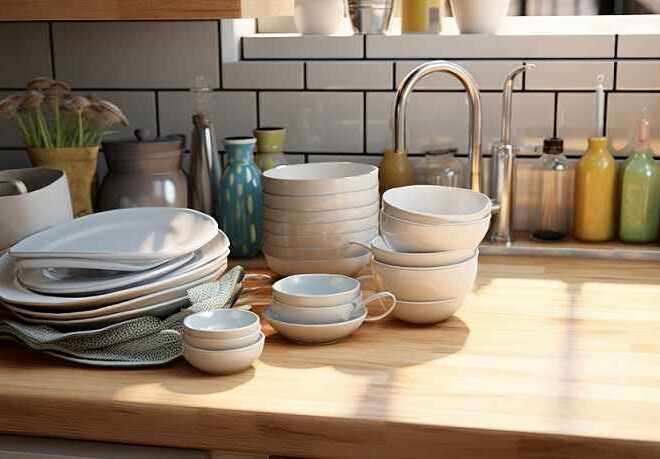
DIY Solutions: How to remove Mold Sling in your Kitchen Sink
Are you tired of that pesky mold creeping into your kitchen sink, turning your culinary haven into a breeding ground for unwanted guests? You’re not alone! Mold sling can be an annoying and stubborn problem, but fear not—there’s no need to call in the pros just yet. In this DIY guide, “remove Mold Sling in your Kitchen Sink” we’ll arm you with simple, effective solutions to tackle mold sling head-on and restore sparkle and freshness to your kitchen sink. Say goodbye to unsightly stains and hello to a cleaner, healthier space where you can whip up your favorite meals without worry. Grab your gloves and let’s dive into the world of quick fixes that will leave mold quaking in its spores!
Introduction to Mold Sling in Kitchen Sinks
A kitchen sink is often the heart of your home, where meals begin and dishes are scrubbed clean. But lurking in those nooks and crannies can be an unwelcome guest: mold sling. If you’ve ever noticed dark, slimy patches around your faucet or drain, you’re not alone. Mold sling thrives in damp environments, making kitchens a perfect breeding ground.
Not only is mold unsightly, but it also presents a health risk, making its removal a priority.Understanding how to remove mold sling from the kitchen sink effectively is essential for maintaining a safe and hygienic space. In this guide, we’ll explore what causes this pesky problem and provide DIY solutions that will have your sink sparkling again in no time!
What is Mold Sling and Why is it Harmful?
Mold sling refers to the dark, fuzzy growth that often appears around your kitchen sink. It’s a type of mold that thrives in damp environments, making sinks an ideal breeding ground. This unsightly mold can spread quickly, affecting not just cleanliness but also health.
The presence of mold sling is more than just an aesthetic issue. Mold spores can become airborne and trigger allergic reactions or respiratory problems for sensitive individuals.Children and pets are especially susceptible to the negative effects of mold.
Moreover, if left untreated, this mold can lead to structural issues over time by damaging grout and caulking materials around the sink area. Ignoring it might create a bigger problem down the line—one that requires extensive cleaning or even renovations. Maintaining awareness about its dangers helps protect both your home and health from unwanted effects.
Causes of Mold Sling in Kitchen Sinks
Mold sling in kitchen sinks often stems from a perfect storm of moisture and organic material. When food particles, grease, or soap scum accumulate, they provide an ideal breeding ground for mold spores.
Poor ventilation plays a significant role as well. A humid environment can trap moisture around your sink area, encouraging mold growth. This is especially common in kitchens where steam from cooking activities lingers.
Neglected cleaning routines also contribute to the issue. Skipping regular scrubs allows mildew to settle in hard-to-reach corners of your sink and plumbing fixtures.
Finally, leaks or plumbing issues that cause water pooling are critical culprits too. They create damp spots that make it easy for mold to flourish right under your nose.
Tools and Materials Needed for DIY Solutions
When tackling mold sling in your kitchen sink, having the right tools and materials is crucial for effective removal. Start with basic cleaning supplies like sponges, scrub brushes, and microfiber cloths. These will help you physically remove mold from surfaces.
Next, gather natural cleaning solutions such as white vinegar and baking soda. Both are powerful yet safe alternatives that cut through grime without harsh chemicals.
For tougher stains or more stubborn mold, consider using bleach or hydrogen peroxide. Always remember to handle these products with care and follow safety guidelines.
Protective gear is also important—wear gloves and a mask to shield yourself from any spores released during cleaning.
Lastly, keep a spray bottle handy for easy application of your chosen solution. This simple setup will make the process smoother while ensuring you effectively address mold issues in your kitchen sink.
Step-by-step Guide to Removing Mold Sling from Kitchen Sink
Before you start cleaning, it’s essential to prepare.Gather your tools and materials—gloves, scrub brushes, natural cleaners like vinegar or baking soda, and bleach if needed. Make sure to ventilate the kitchen for safety.
Start by clearing out any items around the sink area. This ensures you have a clean workspace to tackle the mold sling effectively.
Next, thoroughly clean the sink’s surface with warm soapy water to remove food particles and grime. Rinse well to clear away any residue.
Now it’s time for the cleaning solutions. For a natural approach, apply vinegar or baking soda directly onto affected areas. Let them sit for at least 15 minutes before scrubbing vigorously.
If you opt for stronger chemicals like bleach, dilute it properly first and use it sparingly in well-ventilated spaces.
Don’t forget to rinse everything completely after scrubbing!
Preparation and Safety Measures
Before diving into the mold removal process, it’s essential to prepare properly. Start by gathering all your cleaning supplies and tools nearby.This will allow you to complete the cleaning process without interruption.
Safety should be your top priority. Wear gloves to protect your skin from harsh chemicals or mold spores. A mask is also a wise choice; it helps prevent inhaling any allergens or toxins released during cleaning.
Ventilate the area well by opening windows and turning on exhaust fans if available. Fresh air circulation minimizes exposure to harmful substances, making the task safer.
If you’re using bleach or heavy-duty cleaners, avoid mixing them with other products unless specified safe on labels. Combining certain cleaners can create dangerous fumes that are harmful to breathe in.
Taking these precautions will help set the stage for an effective and secure cleanup experience as you remove mold sling from your kitchen sink.
Cleaning the Sink Area
Start by removing all items from around the sink. This includes sponges, dish soap, and any utensils. Clear space allows for a thorough cleaning process.
Next, wipe down surfaces with a damp cloth to remove loose debris. Pay special attention to corners and edges where grime tends to accumulate.
Once you’ve tackled the visible dirt, grab an old toothbrush or scrub brush. Use it to get into those hard-to-reach spots in the sink’s crevices. These areas often harbor mold and bacteria.
After scrubbing, rinse everything thoroughly with hot water. Hot water helps lift stubborn residues while flushing away loosened particles.
Finish this step by drying the area completely with a clean towel or paper towel. Moisture is mold’s best friend; keeping your sink area dry is essential for preventing future growth.
Applying Natural Cleaning Solutions
When it comes to tackling mold sling in your kitchen sink, natural cleaning solutions can be both effective and eco-friendly. A simple mixture of baking soda and vinegar works wonders. The fizzy reaction helps lift grime while neutralizing odors.
To create this solution, pour half a cup of baking soda down the drain first. Follow it with an equal amount of vinegar. Allow the mixture to bubble for about 15 minutes before rinsing it away with hot water.
Tea tree oil, renowned for its antifungal qualities, is also a viable option.Mix a teaspoon of tea tree oil with two cups of water in a spray bottle. Lightly mist the affected areas and let it sit for an hour before wiping clean.
These natural alternatives not only fight mold but also leave your sink smelling fresh without harmful chemicals or harsh fragrances.
Using Bleach or Other Chemical Cleaners
When dealing with stubborn mold sling, bleach can be a powerful ally. This common household cleaner effectively kills mold spores and helps to restore your sink’s cleanliness.
Before applying bleach, it’s essential to dilute it properly. Mix one part bleach with ten parts water in a spray bottle for safe use. Always wear gloves and ensure good ventilation by opening windows or turning on exhaust fans.
Spray the solution directly onto the affected areas of the sink. Allow it to sit for about 10-15 minutes, giving the bleach time to work its magic.Next, use a soft brush or sponge to gently scrub the surface.
Rinse thoroughly with warm water afterward, ensuring no residue is left behind. If you prefer alternatives to bleach, consider hydrogen peroxide or specialized mould removers that are also effective against kitchen grit and grime without harsh fumes.
Preventing Future Mold Growth
To prevent future mold sling in your kitchen sink, focus on moisture control. Mold thrives in damp environments, so keeping the area dry is crucial. After using your sink, wipe down surfaces with a cloth to remove excess water.
Ensure proper ventilation in your kitchen. Open windows or use exhaust fans to help circulate air and reduce humidity levels. If possible, consider investing in a dehumidifier for particularly humid climates.
Regularly inspect the caulking around your sink and faucet. Cracked or peeling caulk can trap moisture and lead to mold growth. Replace any damaged areas promptly.
Lastly, maintain a cleaning schedule that includes natural anti-mold solutions like vinegar or baking soda at least once a week. This proactive approach will keep mold at bay while ensuring your kitchen remains fresh and inviting.
Alternative Methods for Removing Mold Sling
If DIY solutions aren’t your thing, there are alternative methods for tackling mold sling in your kitchen sink. One option is to hire a professional service. Mold remediation experts have specialized equipment and knowledge to handle extensive infestations safely and effectively.
For those who prefer a hands-on approach but want something ready-made, consider commercial mold removal products. These cleaners come with specific instructions designed for quick application and strong results. Look for products that specifically mention effectiveness against mold.
Always read labels carefully before use, as some chemicals may not be suitable for every surface or could pose health risks if not used properly.
Whether you choose professionals or store-bought solutions, ensure proper ventilation during the process to minimize exposure to fumes or allergens associated with these treatments.
Hiring a Professional Service
When tackling stubborn mold sling in your kitchen sink, sometimes it’s best to call in the experts. Professionals have specialized training and tools that can effectively target mold issues.
These services often provide a thorough inspection before treatment, ensuring they address the root cause of the problem rather than just masking it. They understand different types of mold and how to eliminate them safely.
Also, a professional’s help saves time and energy.Instead of scrubbing away for hours with little success, you can focus on other important tasks while they handle the dirty work.
Moreover, professional services usually offer warranties or guarantees on their work. This means if the issue resurfaces within a certain period, they’ll return at no extra cost to rectify it. It’s peace of mind knowing you’re covered if something goes awry again later on!
Using Commercial Mold Removal Products
When considering how to remove mold sling from a kitchen sink, commercial mold removal products can be an efficient choice. These specialized solutions are formulated to target and eliminate mold spores effectively.
Before you begin, carefully read the instructions on the label. Different products may have varying application methods and safety precautions.
Spray or apply the product directly onto the affected areas of your sink. Allow it to sit for the recommended time to ensure maximum effectiveness against persistent molds.
Afterward, scrub with a non-abrasive brush or cloth for thorough cleaning. Rinse thoroughly with water to remove any residue left behind by the cleaner.
Always wear gloves and ensure proper ventilation when using these chemicals. This helps protect you from harsh fumes while promoting safer indoor air quality during your cleaning process.
Tips for Maintaining a Clean and Mold-Free Sink
To keep your kitchen sink mold-free, establish a daily cleaning routine. A quick rinse after each use can prevent residue build-up.
Use a soft sponge or cloth to wipe the sink dry. This simple habit reduces moisture that molds thrive on.
Incorporate vinegar into your weekly cleaning schedule. Its natural acidity helps eliminate any lingering spores without harsh chemicals.
Check for leaks regularly around faucets and pipes. Any dampness can contribute to mold growth, so fixing minor issues promptly is crucial.
Consider using baking soda as an occasional scrubber. It’s effective at removing stains while being gentle on surfaces.
Lastly, ensure proper ventilation in your kitchen. Open windows or use exhaust fans to decrease humidity levels during cooking activities. Keeping the air circulating is vital for a healthy space free from unwanted guests like mold.
Conclusion: Importance of Regular Cleaning and Maintenance.
Regular cleaning and maintenance play a crucial role in keeping your kitchen sink free from mold sling. By making it a habit to clean your sink frequently, you’re not only improving the aesthetic of your kitchen but also promoting a healthier environment for you and your family. Mold thrives in damp, dark places, so ensuring that these areas are regularly dried and cleaned can significantly reduce the chances of mold growth.
Investing just a little time each week to scrub the surfaces and use natural or commercial cleaners when needed can save you from more extensive problems down the road. Remember that prevention is key; maintaining proper ventilation in your kitchen can also help keep moisture at bay. Embracing these practices will go a long way toward ensuring that your kitchen remains fresh, inviting, and most importantly—mold-free. Taking care of this small area within your home contributes greatly to overall hygiene and well-being.


